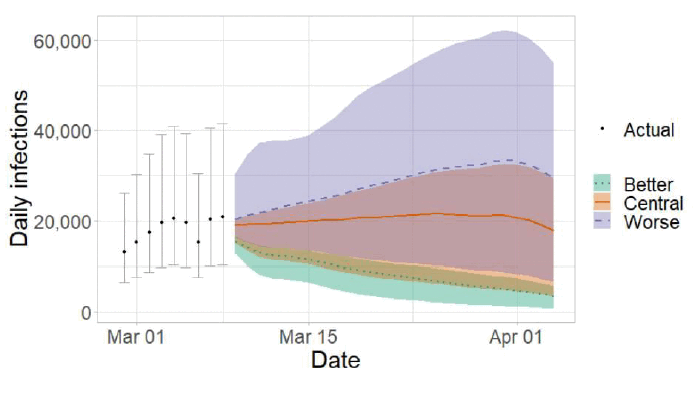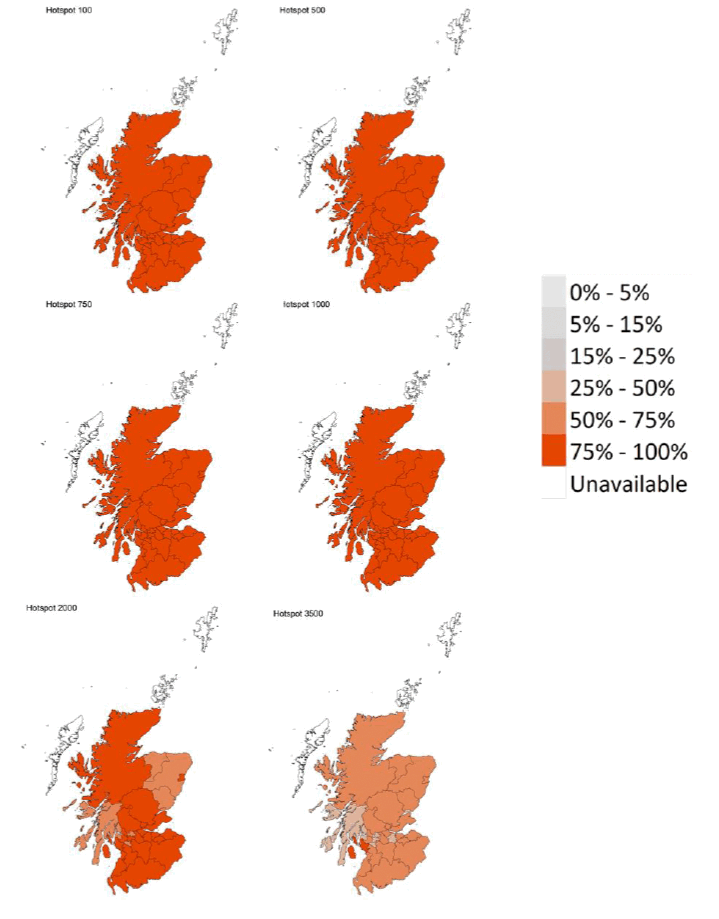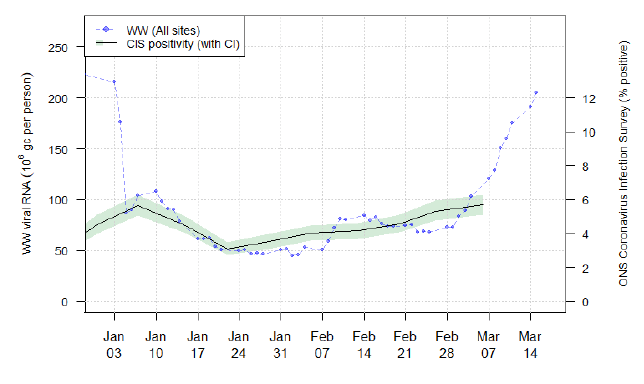Coronavirus (COVID-19): modelling the epidemic (issue no.94)
Latest findings in modelling the COVID-19 epidemic in Scotland, both in terms of the spread of the disease through the population (epidemiological modelling) and of the demands it will place on the system, for example in terms of health care requirement.
Coronavirus (Covid-19): modelling the epidemic in Scotland (Issue No. 94)
Background
This is a report on the Scottish Government modelling of the spread and level of Covid-19 in Scotland. This updates the previous publication on modelling of Covid-19 in Scotland published on 10th March 2022. The estimates in this document help the Scottish Government, the health service and the wider public sector plan and put into place what is needed to keep us safe and treat people who have the virus.
This edition of the research findings focuses on the epidemic as a whole, looking at estimates of R, growth rate and incidence as well as local measures of change in the epidemic.
Key Points
- The reproduction rate R in Scotland is currently estimated as being between 1.0 and 1.3, as at 1st March 2022. The lower and upper limits have increased since last week.
- The daily growth rate for Scotland is currently estimated as between ‑1 and 3% as at 1st March. The upper limit has increased since last week.
- The number of new daily infections for Scotland is estimated as being between 278 and 692 as at 1st March, per 100,000 people.
- Average contacts from the most recent Panel A cohort of the Scottish Contact Survey (week ending 9th March) indicate an average of 4.8 contacts.
- Mean contacts within the work and other setting (contacts outside home, school and work) have increased within the last two weeks by 18% and 36% respectively. Contacts within the home have decreased by 5% levels over the same period.
- Individuals within the youngest age groups (18-59) have all reported a rise in contacts within the last two weeks, with the 18-29 age group increasing by approximately 55%. Increases are largely driven by a rise in contacts in the work and other setting (contacts outside home, school and work). Those within the oldest age groups (60+) have decreased their contacts in the last two weeks.
- The 18-29 age group has increased interactions with all age groups within the last two weeks. Interactions between those aged 13-17 and individuals aged 40-49 have reported the biggest decrease.
- Visits to an outside event have shown the biggest increase, increasing from approximately 58% to 63% followed by visits to a pub or restaurant increasing from 45% to 49% in the last two weeks.
- The number of people wearing a face covering where they have at least one contact outside of the home has remained high at approximately 84%.
- Approximately 75% of individuals had taken at least one lateral flow test within the last 7 days for the survey pertaining to the 3rd March - 9th March, decreasing from 80% two weeks prior.
- Approximately 29% of individuals believe they have had Covid-19 at least once since March 2020.
- The future trajectory of infections, hospitalisations, hospital occupancy and deaths is still uncertain. We estimate that daily infections may be up to 49,000 in early April.
- Modelled rates of positive tests per 100K using data to 14th March indicate that, for the week commencing 27th March, all 29 of the local authorities included are expected to exceed 100 cases per 100K with at least 75% probability. These same 29 local authorities also have at least a 75% probability of exceeding 1000 cases per 100K.
- 21 of the 29 local authorities included are expected to exceed 2000 cases per 100K with at least 75% probability. The exceptions are Aberdeenshire, Angus, Argyll & Bute, Dundee, East Dunbartonshire, East Renfrewshire, Inverclyde and Moray.
- One local authority (North Ayrshire) is expected to exceed 3500 cases per 100K with at least 75% probability.
- Nationwide, wastewater Covid-19 RNA levels have increased rapidly. The week ending on 15th March saw levels of 206 million gene copies per person per day (Mgc/p/d), an increase of almost three times than two weeks prior (71 Mgc/p/d).
Recent cases
Figure 1 shows the number of Covid-19 cases (from either PCR or LFD) in Scotland between January and March 2022. The vertical dashed lines indicate the cut off points for each of the modelling inputs; after these dates, the number of cases is not incorporated into the outputs.

R, growth rate and incidence are as of 1st March 2022 (dashed line 1). The Scottish Contact Survey uses data to 9th March 2022 (dashed line 2). The Scottish Government modelling of infections and hospitalisations, and the modelled rates of positive tests per 100K use data to 14th March (dashed line 3). The wastewater analysis uses data to 15th March 2022 (dashed line 4).
Overview of Scottish Government Modelling
Modelling outputs are provided here on the current epidemic in Scotland as a whole, based on a range of methods. Because it takes a little over three weeks on average for a person who catches Covid-19 to show symptoms, become sick, and either die or recover, there is a time lag in what our model can tell us about any change in the epidemic.
This week the Scottish Government presented two outputs to EMRG. The first uses the number of positive LFD or PCR tests, as published by PHS Scotland. The second uses wastewater data. These outputs are included in Figures 2 and 3.
The R value and growth rates are estimated by several independent modelling groups based in universities and the UKHSA. Estimates are considered, discussed and combined at the Epidemiology Modelling Review Group (EMRG), which sits within the UKHSA. These are based on data to 14th March.
UKHSA's consensus view across these methods was that the value of R in Scotland[2] is between 1.0 and 1.3, as of 1st March 2022[3] (Figure 2). The lower and upper limits have increased since last week. R is an indicator that lags by two to three weeks.

Source: EMRG
The consensus from UKHSA for this week is that the growth rate in Scotland is between -1% and 3% per day as at 1st March. The upper limit has increased since last week.
The various groups which report to the EMRG use different sources of data in their models to produce estimates of incidence (Figure 3). UKHSA's consensus view across these methods, as at 1st March, was that the incidence of new daily infections in Scotland was between 278 and 692 new infections per 100,000. This equates to between 15,200 and 37,800 people becoming infected each day in Scotland.

Source: EMRG
What we know about how people's contact patterns have changed
Average contacts from the most recent Panel A cohort of the Scottish Contact Survey (week ending 9th March) indicate an average of 4.8 contacts. This has increased by 28% compared to the previous Panel A of the survey (week ending 23rd February), as seen in Figure 4. Mean contacts within the work and other setting (contacts outside home, school and work) have increased within the last two weeks by 18% and 36% respectively. Contacts within the home have decreased by 5% over the same period.

Figure 5 shows how contacts change across age group and setting. Individuals within the youngest age groups (18-59) have all reported a rise in contacts within the last two weeks, with the 18-29 age group increasing by approximately 55%. Increases are largely driven by a rise in contacts in the work and other setting (contacts outside home, school and work). Those within the oldest age groups (60+) have decreased their contacts in the last two weeks.

The heatmaps in Figure 6 show the mean overall contacts between age groups for the weeks relating to 17th February - 23rd February and 3rd March - 9th March and the difference between these periods. The 18-29 age group has increased interactions with all age groups within the last two weeks. Interactions between those aged 13-17 and individuals aged 40-49 have reported the biggest decrease.

The biggest changes in the proportion of participants visiting different locations is seen in those visiting an outside event and individuals visiting a pub or restaurant. Visits to an outside event have shown the biggest increase, increasing from approximately 58% to 63% followed by visits to a pub or restaurant increasing from 45% to 49% in the last two weeks as shown in Figure 7.

Figure 8 shows the number of people wearing a face covering where they have at least one contact outside of the home. This has remained high at approximately 84%.

Approximately 75% of individuals had taken at least one lateral flow test within the last 7 days for the survey pertaining to the 3rd March - 9th March, decreasing from 80% two weeks prior as shown in Figure 9.

Figure 10 shows that approximately 29% of individuals believe they have had Covid-19 at least once since March 2020. Of those who think they have had Covid-19, 80% have had this confirmed through a test.

What the modelling tells us about estimated infections and hospitalisations
The Scottish Government assesses the impact of Covid-19 on the NHS in the next few weeks. Figures 11 - 13 show projections over three weeks.
These projections include the effect of booster take up. 'Central' assumes that transmissibility remains at current levels. 'Worse' assumes a higher transmissibility, whereas 'Better' assumes a lower transmissibility. These projections do not include the changes to restrictions announced on 15th March.
The future trajectory of infections is uncertain.

We estimate that daily infections may be up to 49,000 in early April.
Figure 12 shows the impact of the projections on the number of people in hospital. The modelling includes all hospital stays, whereas the actuals only include stays up to 28 days duration that are linked to Covid-19.
There continues to be uncertainty over hospital occupancy and intensive care in the next three weeks.

Figure 13 shows the impact of the projection on ICU bed demand.

What the modelling tells us about projections of hospitalisations, occupancy and deaths in the medium term
SPI-M-O produces projections of the epidemic (Figures 14 - 16), combining estimates from several independent models. These projections are not forecasts or predictions. They represent a scenario in which the trajectory of the epidemic continues to follow the trends that were seen in the data available to 14th March and do not include the effects of any future policy or behavioural changes.
The delay between infection, developing symptoms, the need for hospital care, and death means they cannot fully reflect the impact of behaviour changes in the two to three weeks prior to 14th March.
The projections include the potential impact of vaccinations over the next few weeks. Modelling groups have used their expert judgement and evidence from UKHSA, Scottish Universities & Public Health Scotland, and other published efficacy studies when making assumptions about vaccine effectiveness.

Figure 15 shows the SPI-M-O consensus on hospital occupancy. Hospital occupancy is determined by the combination of admissions and length of stay, the latter of which is difficult to model with confidence.

Some models are struggling to fit to both the recent trends in Covid-19 hospital occupancy and admissions in Scotland. Producing reliable projections is challenging with the current trends in different data streams.
Figure 16 shows the SPI-M-O consensus on daily Covid-19 deaths.

What we know about which local authorities are likely to experience high levels of Covid-19 in two weeks' time
We continue to use modelling based on Covid-19 cases and deaths using data to 14th March from several academic groups to give us an indication of whether a local authority is likely to experience high levels of Covid-19 in the future. This has not been compiled via UKHSA into a consensus this week and is based on one modelling group.
In less populated regions in which case numbers are small, there is a greater variation in model estimates, and hence increased uncertainty. This has led to us not including Na h-Eileanan Siar, Orkney Islands and Shetland Islands this week.
In this, an area is defined as a hotspot if the two week prediction of cases (positive tests) per 100K population is predicted to exceed a threshold, e.g. 500 cases.
Modelled rates of positive tests per 100K using data to 14th March (Figure 17) indicate that, for the week commencing 27th March, all 29 of the local authorities included are expected to exceed 100 cases per 100K with at least 75% probability. These same 29 local authorities also have at least a 75% probability of exceeding 1000 cases per 100K.
21 of the 29 local authorities included are expected to exceed 2000 cases per 100K with at least 75% probability. The exceptions are Aberdeenshire, Angus, Argyll & Bute, Dundee, East Dunbartonshire, East Renfrewshire, Inverclyde and Moray.
One local authority (North Ayrshire) is expected to exceed 3500 cases per 100K with at least 75% probability.
We have not included the 50 threshold in Figure 17 this week due to the addition of some higher threshold levels. These thresholds levels are the same as for the 100 threshold. The full set of numbers are included in Table 1 in the Technical Annex.

What can analysis of wastewater samples tell us about local outbreaks of Covid-19 infection?
Levels of Covid-19 RNA in wastewater (WW) collected at a number of sites around Scotland are adjusted for population and local changes in intake flow rate (or ammonia levels where flow is not available). See Technical Annex in Issue 34 of these Research Findings for the methodology.
Nationwide, wastewater Covid-19 levels have increased rapidly. The week ending on 15th March saw levels of 206 million gene copies per person per day (Mgc/p/d), an increase of almost three times than two weeks prior (71 Mgc/p/d).
This week saw wastewater sampling levels increased compared to previous weeks, at 207 samples.
In Figure 18, we restrict plotting to the period after the end of 2021, at which point S-gene dropout testing data suggest that nearly all cases are from the Omicron variant. In this period, WW testing should have a consistent relationship with Covid-19 prevalence, assuming that the change in relationship is due to the new dominant variant and there is no shedding difference with Omicron BA.2. We also superimpose data from the ONS Coronavirus Infection Survey (CIS) to 5th March, with axis scaling chosen to match post-2021 levels in both datasets. Note that this scaling is not the same as that used in reports prior to 1 January 2022, where a scaling based on 2021 data was used.
In this graph, we see a rapid increase in WW Covid-19 levels starting from the end of February. This latest increase appears substantially more rapid than the increases seen in CIS and in WW RNA levels from late January, although the CIS does not cover the most recent time period and the WW Covid-19 levels show greater variability.

The maps in Figure 19 show population weighted average WW viral Covid-19 levels for each local authority for the last week, with changes relative to the previous week. These show a clear increase in Covid-19 levels across much of Scotland.

Long Covid
A report on the rate of long Covid has not been included this week. We will report the long Covid projections again once updated estimates of self-reported long Covid prevalence amongst those infected with the less severe Omicron variant become available.
What next?
Modelling will continue to look at the impact of Omicron, particularly the variant BA.2. As the year progresses we will incorporate different models as and when it is appropriate to do so.
We hope to include our analysis on long Covid in future weeks.
UKHSA is considering a change in the frequency that Covid-19 estimates are published, to every two weeks from 1st April. This would mean that this Modelling the Epidemic publication would also move to every two weeks from 1st April. If you have any feedback about this, please contact UKHSA at enquiries@ukhsa.gov.uk.
Contact
There is a problem
Thanks for your feedback